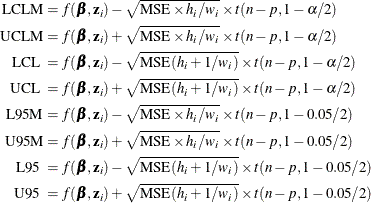The NLIN Procedure
- Overview
-
Getting Started

-
Syntax

-
Details
 Automatic DerivativesMeasures of Nonlinearity, Diagnostics and InferenceMissing ValuesSpecial VariablesTroubleshootingComputational MethodsOutput Data SetsConfidence IntervalsCovariance Matrix of Parameter EstimatesConvergence MeasuresDisplayed OutputIncompatibilities with SAS 6.11 and Earlier Versions of PROC NLINODS Table NamesODS Graphics
Automatic DerivativesMeasures of Nonlinearity, Diagnostics and InferenceMissing ValuesSpecial VariablesTroubleshootingComputational MethodsOutput Data SetsConfidence IntervalsCovariance Matrix of Parameter EstimatesConvergence MeasuresDisplayed OutputIncompatibilities with SAS 6.11 and Earlier Versions of PROC NLINODS Table NamesODS Graphics -
Examples

- References
By default, the parameter confidence intervals are computed using the Wald-based formula:
where ![]() is the ith parameter estimate,
is the ith parameter estimate, ![]() is its estimated standard error,
is its estimated standard error, ![]() is a t statistic with
is a t statistic with ![]() degrees of freedom, n is the number of usable observations, and p is the number of parameters. You can specify the significance level
degrees of freedom, n is the number of usable observations, and p is the number of parameters. You can specify the significance level ![]() used in constructing these confidence limits with the ALPHA=
option in the PROC NLIN
statement; the default value is
used in constructing these confidence limits with the ALPHA=
option in the PROC NLIN
statement; the default value is ![]() .
.
Because Wald-based confidence intervals are only asymptotically valid, you can use the BOOTSTRAP statement to request bootstrap-based confidence intervals. Furthermore, you can augment these confidence intervals with confidence curves for a more complete inference on confidence intervals. For more information, see the section Bootstrap Resampling and Estimation and Profiling Parameters and Assessing the Influence of Observations on Parameter Estimates.
Model confidence intervals are output when an OUT= data set is specified and one or more of the keywords LCLM , UCLM , LCL , UCL , L95M= , U95M= , L95= , and U95= is specified. The expressions for these terms are as follows:

where ![]() is the leverage,
is the leverage, ![]() , and
, and ![]() is the ith row of
is the ith row of ![]() . These results are derived for linear systems. The intervals are approximate for nonlinear models. The value
. These results are derived for linear systems. The intervals are approximate for nonlinear models. The value ![]() in the preceding formulas for LCLM
, UCLM
, LCL
, and UCL
can be set with the ALPHA=
option in the PROC NLIN
statement or with the ALPHA=
option in the OUTPUT
statement. If both ALPHA= options are specified, the option in the OUTPUT
takes precedence.
in the preceding formulas for LCLM
, UCLM
, LCL
, and UCL
can be set with the ALPHA=
option in the PROC NLIN
statement or with the ALPHA=
option in the OUTPUT
statement. If both ALPHA= options are specified, the option in the OUTPUT
takes precedence.